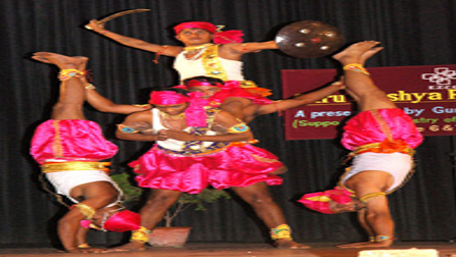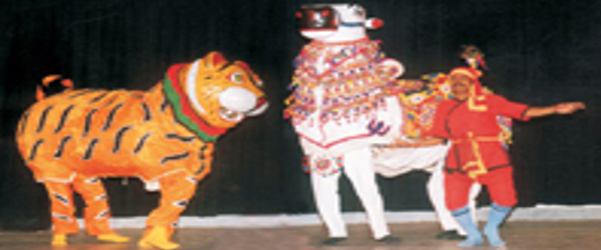|
||
|
|
||
|
Western Orissa - a land of myths, which owe their origin to the legendary Goddess Sambleswari is known for its rich and colourful folk and tribal art forms. A wide range of percussion instruments is used as accompaniments to the Sambalpuri Dances. Hundreds of quaint musical instruments like the Sanchar, Samprada, Ghumra, Madal and Ghanta Vadya are also used. A variety of dance styles like the Dalkhai, Raserkeli, Nachnia, Bajnia, Maelajhara and Chutkachuta, explore the many moods and shades of human life.
Melodious songs and lilting music characterize the
Dalkhai Dance. The dance is performed by the young
unmarried girls of the village, who pray to goddess
Dalkhai for the well being of their brothers. The
daughters of the village fast the entire day and
pray to the Folk Goddess in the evening. The songs
describe the everyday life of the villagers and
celebrate the beauty of the young girls. The
traditional costumes and ornaments worn by the
dancers, add aesthetic appeal to the dance. The
Dalkhai Geet (song), Dalkhai Nacha (dance) and
Dalkhai Baja (music) create an atmosphere of gaiety
and merrymaking.The accompanying musical instruments
include the Dhol, Nishan, Tasha & Muhuri. The dance
is performed on the eighth day of the full moon
night of Ashtami. Dalkhaire is the oft repeated word
in the songs.
Nachnia, a dance usually performed by male artistes
only, originated from the Sonepur district of
Orissa. The dance is associated with the ceremony of
marriage. The leader of the group of dancers is
known as gahar while his companions are called palia.
The music, which accompanies this dance, is usually
restricted to drums, and is played to a particular
rhythm called Kaharba. Bajnia is a traditional folk dance of Western Orissa. Music is an important element of this fast paced and cheerful dance form. The men use an array of musical instruments to provide accompaniment to the women dancers. Often the men too join in the dancing. The dancers wear colourful local hand-woven Sambalpuri sarees and dhotis.
Raserkeli is another folk dance of Western Orissa.
In this dance too, the women are the dancers and the
men provide the musical accompaniment. This dance is
performed mainly during marriage ceremonies. The
item begins with a musical piece called Dulduli. The
player of the Dhol during this dance is called the
Dhulia. The Dhulia and the dancers spread goodwill
through their movements and their smiling faces.
Maelajhoda is another dance form of Western Orissa,
which is performed by young unmarried girls. The
technique of the dance and the musical
accompaniments used are similar to the Dalkhai
dance. Differences exist in the movements of the
hands and feet.
The Chutkichuta Dance is also from Sambalpur in
Western Orissa. This dance is dedicated to Goddess
Sambleswari. Based on the various ragas of the
Sambalpuri folk tradition and accompanied by
melodious songs, this dance form reflects the rich
culture of indigenous art forms in this part of
Orissa. Durla Nacha is another traditional folk dance of Western Orissa. The dance is an integral part of the marriage festivities of the tribal communities. On the morning of the marriage, oil and turmeric paste are first offered to the family deity and then to the groom and bride. Singing and dancing accompany the ceremony.
|
||
|
GHUMRA DANCE ORRISA |
||
|
Ghumra is a folk dance of the Kalahandi district of
Orissa. It is named after the main musical
instrument, a pitcher-shaped drum called the ghumra,
which is tied around each dancer's neck. The dancers
play on the drum while dancing. It is performed to
the accompaniment of songs, the content of which is
varied, ranging from stories of hunting to everyday
joys and sorrows of the people. The dancers execute
intricate movements, jumps and pirouettes in a fast
tempo. The Ghumra is popular in Bolangir, Sambalpur
and Cuttack. With love as its main theme, the Ghumra
is a common dance at social functions such as
marriages. The Saora tribes and other aboriginal
tribes mostly perform this dance |
||
|
PAIKA DANCE |
||
 |
The Paika Dance is a martial art form of ancient Orissa, which has withstood the test of time. Paika Akhadas thrive in several villages of the state till today. As early as the 15th century A.D., Gajapati Raja was believed to have raised an army of Paika warriors. The brave Paikas raise their voice of rebellion against the British rulers as early as 1817, four decades before the Sepoy Mutiny broke out. Buxi Jagabandhu Bidyadhar Mahapatra Bhramarabar Roy led the Paika Bidroha. The Paiks of Khorda did not allow the British to enter the region and that is why Khorda is known as the last freedom fort of India. The heroism of these warriors influenced the art, architecture and literature of Orissa. The carvings that adorn the Konark Temple depict the martial prowess of the Paikas. Many of the performing art froms of Orissa, namely the Mayurbhanj Chhau, Ghumura and Ranapa Dances have been influenced by this glorious martial tradition. The Paikas have found pride in place in Oriya literature too. Sarala Dasa's Mahabharat written in the 15th century describes this martial tradition of Orissa. Poet Balaram Dash narrates the institution of war fare education in his literary work Jagamohan Ramayan. The dance involves acrobactic movement with swords (talwars), sticks (lathis) and shields (dhalis). Not surprisingly, the dance demands of it performers an extraordinary level of physical fitness. Only through years of dedicated practice do these dancers master the precision and agility that is the hallmark of the Paika Dance. The dance is often an integral part of Dushera and Kalipuja celebrations. The Chagi, Nagar, Dhamsa, Mahuri and large cymbals provide the musical accompaniment. |
|
|
PASHU DANCE ORRISA |
||
 |
The Pasu Nritya or the Animal Mask Dance belongs to a majestic folk dance tradition of Orissa, particularly in the Ganjam district. Ma Byaghra Devi and Ma Thakurani are the popular Goddesses of this area. During festivals, when the idols are taken out on the streets (Thakurani Yatra), the masked dancers lead the procession in their colourful costumes. Pasu Nritya is also an important part of marriage ceremonies where the dancers lead the bridegroom and his family to the bride's house. The different kinds of animal mask dances include dances wearing the masks of lions, tigers, bulls, horse, deer, goats, peacocks, ducks etc. The movements vary according to the kind of animal the dancers represent. The animal's body is made out of a cane frame, which is richly decorated. Two dancers wear the cane frame representing the animal's body, while their legs become the quadruped beast's legs. The ring master (director) leads the animals around the stage accompanied by the drummers.
|
|
|
GOTI PUHA ORRISA |
||
|
The Gotipua Dance emerged from the ruins of the Devadasi tradition. From the 14th century onwards, political unrest and social changes took a toll on the Mahari or Devadasi tradition. During this time, attempts were made to keep alive the beautiful tradition of dance thus was born the Gotipua tradition. The Gotipuas were young boys who were trained in singing, dancing and acrobatics in the village clubs or akhadas. They were dressed as girls and performed at temple festivals as well as various social and religious occasions. They also performed at special festive occasions relating to Radha and Krishna, like the Dol Utsav (or Spring Festival), the Chandan Yatra (or boat ride of Madan Mohan and Radhika on Chandan Pushkar) and the Jhulan Yatra (or Swing Festival). It is believed that the Gotipuas began their performance in the later medieval period, during the reign of the Bhoi King Ramachandradev. The present forms of Odissi dance have been derived to a great extent from the Gotipua tradition. Though the dances of the Gotipuas are in the Odissi style, crucial differences exist in technique, costume and presentation. Interestingly, the Gotipua dancers are the singers too. The word Gotipua comes from the words goti meaning one and pua meaning boy. Gotipuas lead a life of rigorous training and exercise under the supervision of their gurus. Boys dedicated to the Lord by their parents are trained to become Gotipua dancers. Couples pray to Lord Balunakeswar Dev to be blessed with a male progeny. If the Lord answers their prayers, the child is dedicated to the Lord at the age of six years and becomes a Gotipua. He stays with the other Gotipuas till he is sixteen years old. When small children fall seriously ill, their parents offer prayers at the temple of Balunakeswar Dev. If the child is cured, he too is dedicated to the temple. In its present form, the Gotipua Dance is more precise and systematic in its conception. Its repertoire includes Vandana (prayer to God, or a guru), Abhinaya (the enactment of a song) and Bandha Nritya (rhythms of acrobatic postures) which is a unique presentation in which gotipuas dance and compose themselves in various acrobatic yogic postures creating the forms of Radha and Krishna. Bandha Nritya is a demonstration of physical prowess requiring great agility and flexibility. Preferably performed in adolescence, with age, this dance form becomes increasingly difficult to execute. The dancers make extensive use of their hands and feet, and one cannot help admire the acrobatics involved in this dance. Musical accompaniment to the Gotipua Dance is provided by the mardala (a pakhawaj), gini (small cymbals), harmonium, violin and flute. The philosophy of the Gotipuas is embedded in the Sakhibhava Culture where the devotees consider themselves to be consorts of Lord Krishna. |
||

